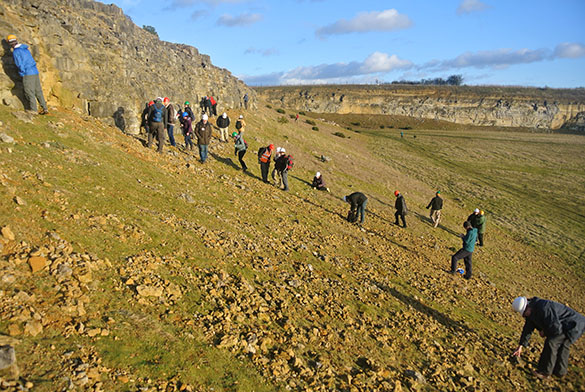 LEEDS, ENGLAND–It was my good fortune to attend this week the 58th Annual Meeting of the Palaeontological Association in Leeds, Yorkshire, this week. I very much enjoy these meetings because of the high quality of the talks and posters, the collegiality, the field trips, and my chance to meet new colleagues and learn more about fossils and the history of life. This year I was here as a representative of the Paleontological Society and one of the Palaeontological Association’s North American Representatives. The last such meeting I attended was in Dublin in 2012.
LEEDS, ENGLAND–It was my good fortune to attend this week the 58th Annual Meeting of the Palaeontological Association in Leeds, Yorkshire, this week. I very much enjoy these meetings because of the high quality of the talks and posters, the collegiality, the field trips, and my chance to meet new colleagues and learn more about fossils and the history of life. This year I was here as a representative of the Paleontological Society and one of the Palaeontological Association’s North American Representatives. The last such meeting I attended was in Dublin in 2012.
One of the main attractions of any geological meeting are the associated field trips. Today a busload of hardy paleontologists had a field trip to the moors of northeastern Yorkshire to see Upper Jurassic limestones and fossils. The image above is from Spaunton Quarry (see below). It is no accident that this scene looks a bit stark — there was a cold wind blowing all day. Yorkshire in December is not surprisingly a bit chilly. We avoided the usual rain, though, and had a splendid day.
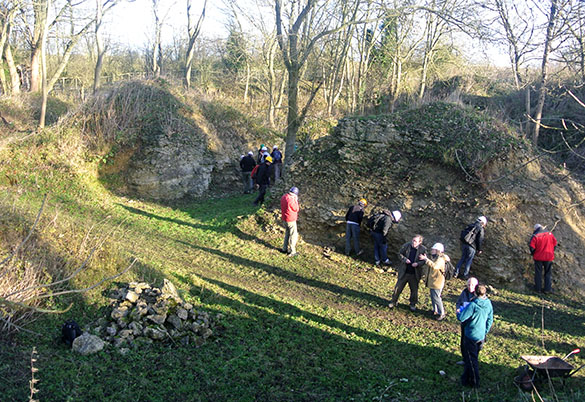 All our outcrops were in the Cleveland Basin, a depositional center in northeastern Yorkshire during the Late Jurassic (Oxfordian Stage). Our first stop was in the disused South Quarry at Betton Farm, where the Betton Farm Coral Bed and Malton Oolite Member is exposed (N54.25517°, W000.46503° — that cool “W000” means we are almost on the Prime Meridian). Above you see the old quarried walls in this small excavation.
All our outcrops were in the Cleveland Basin, a depositional center in northeastern Yorkshire during the Late Jurassic (Oxfordian Stage). Our first stop was in the disused South Quarry at Betton Farm, where the Betton Farm Coral Bed and Malton Oolite Member is exposed (N54.25517°, W000.46503° — that cool “W000” means we are almost on the Prime Meridian). Above you see the old quarried walls in this small excavation.
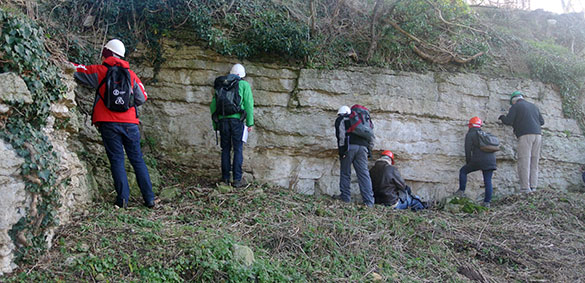 This is the western face of the quarry showing flat bedding of a coral-rich carbonate sand facies. To the right, out of view, is a contemporaneous coral reef (see below).
This is the western face of the quarry showing flat bedding of a coral-rich carbonate sand facies. To the right, out of view, is a contemporaneous coral reef (see below).
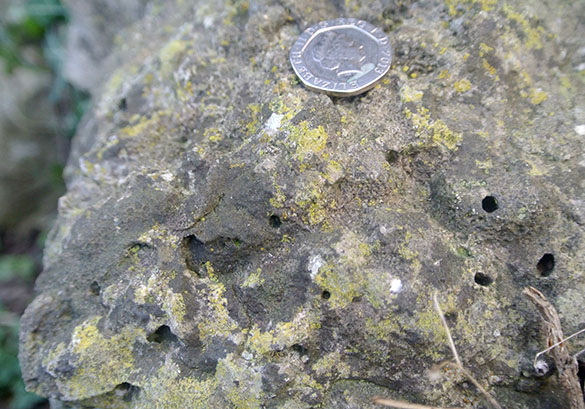 This is the upper surface of the scleractinian coral Thamnasteria concinna, with a few bivalve borings (Gastrochaenolites). I would not be a happy paleontologist if I had to study these poorly-preserved corals. For contrast, you might remember the Jurassic corals of southern Israel. There’s a lot to be said for desert weathering and protective layers of marl.
This is the upper surface of the scleractinian coral Thamnasteria concinna, with a few bivalve borings (Gastrochaenolites). I would not be a happy paleontologist if I had to study these poorly-preserved corals. For contrast, you might remember the Jurassic corals of southern Israel. There’s a lot to be said for desert weathering and protective layers of marl.
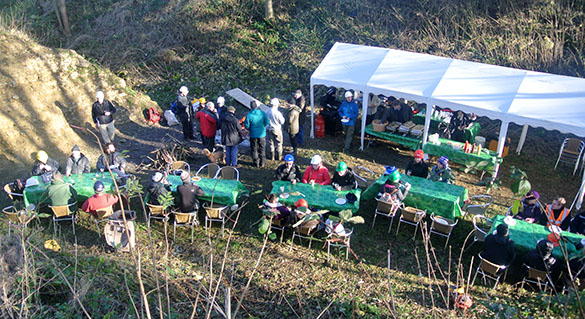 We had a wonderful lunchtime barbecue set up for us in the quarry. Who would guess we’d have an outdoor feast in December in northern England?
We had a wonderful lunchtime barbecue set up for us in the quarry. Who would guess we’d have an outdoor feast in December in northern England?
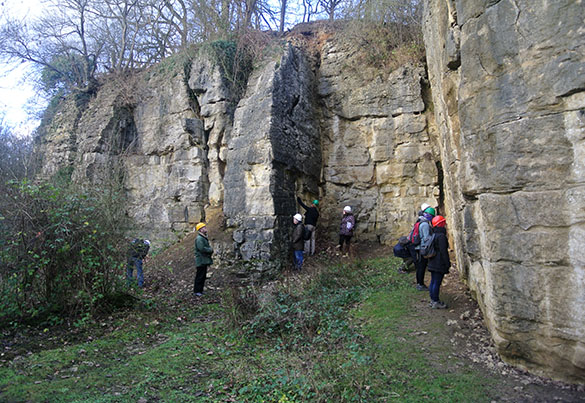 Our second stop was at another abandoned quarry, Ravenswick (N54.25517°, W000.46500°). The Malton Oolite, which was exploited as a building stone, is exposed here. You can see the flat bedding and jointing of this rock that made it good for construction materials.
Our second stop was at another abandoned quarry, Ravenswick (N54.25517°, W000.46500°). The Malton Oolite, which was exploited as a building stone, is exposed here. You can see the flat bedding and jointing of this rock that made it good for construction materials.
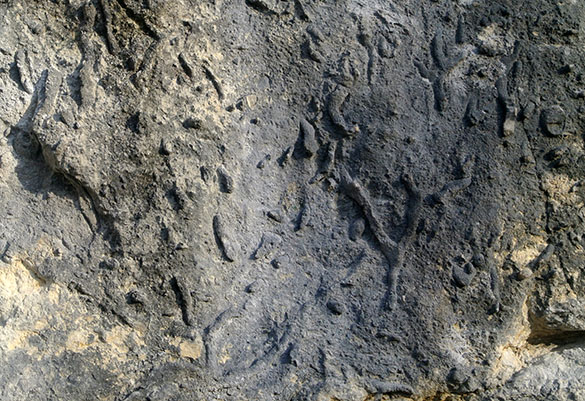 Above the Malton Oolite is the Coral Rag Member. The branching corals shown above are Rhabdophyllia phillipsi. Since they were originally aragonitic skeletons, their later recrystallization into calcite has reduced the amount of fine detail preserved.
Above the Malton Oolite is the Coral Rag Member. The branching corals shown above are Rhabdophyllia phillipsi. Since they were originally aragonitic skeletons, their later recrystallization into calcite has reduced the amount of fine detail preserved.
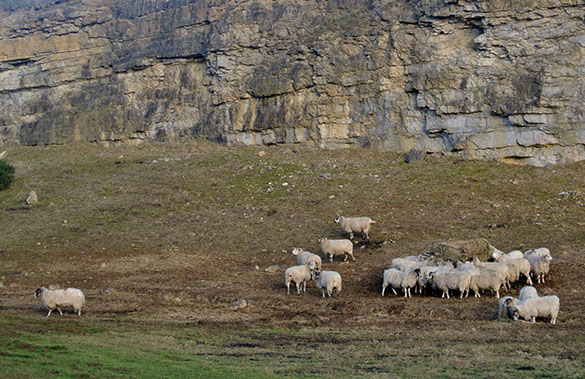 Our final stop was in the sheepiferous Spaunton Quarry (N54.27846°, W000.89128°). The Coralline Oolite Formation is shown above. You may again note the structural features that make this a good building stone.
Our final stop was in the sheepiferous Spaunton Quarry (N54.27846°, W000.89128°). The Coralline Oolite Formation is shown above. You may again note the structural features that make this a good building stone.
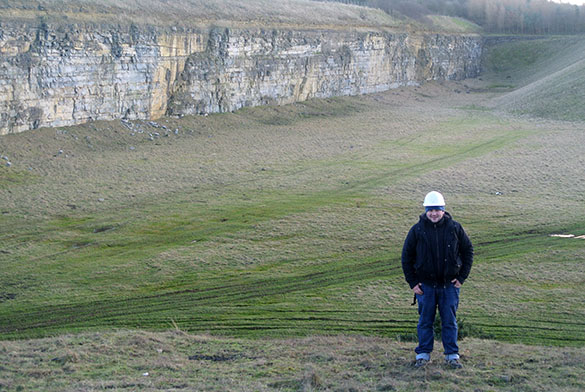 My Polish friend Tomasz Borszcz is shown above with the Coralline Oolite Formation and, immediately above, the Upper Calcareous Grit Formation. Fossils were not common here, but we did see an ammonite in the grit and some echinoid fragments in the Oolite.
My Polish friend Tomasz Borszcz is shown above with the Coralline Oolite Formation and, immediately above, the Upper Calcareous Grit Formation. Fossils were not common here, but we did see an ammonite in the grit and some echinoid fragments in the Oolite.
Thank you very much to Dr. Crispin Little of the University of Leeds for leading this great field trip. I enjoy seeing Jurassic rocks anywhere, but they were especially attractive on the rolling moors of Yorkshire.



Yorkshire will welcome you back next summer, I hope, with rocks more giving of their fossils than those you saw this time round.
Paul
Pingback: Yorkshire Coast Fossils – FossilHub